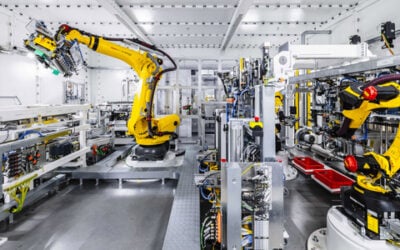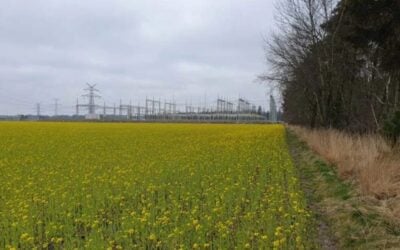
The “momentum behind energy storage,” leading to its wider adoption across the grid in Europe is becoming increasingly undeniable, Energy-Storage.news Premium has heard.
Speaking with the site at last month’s Energy Storage Summit EU, Florian Mayr, a strategy, business development, and transactions expert at advisory group Apricum, said that there has been a fundamental change in the way the technology is viewed by policymakers and regulators, particularly at the European Union (EU) level.
Enjoy 12 months of exclusive analysis
- Regular insight and analysis of the industry’s biggest developments
- In-depth interviews with the industry’s leading figures
- Annual digital subscription to the PV Tech Power journal
- Discounts on Solar Media’s portfolio of events, in-person and virtual
There is growing recognition in the European Union that “energy storage has to be part of the equation” in providing flexibility to an electricity system increasingly reliant on low-carbon energy sources, Mayr said.
When the first draft plans for the EU Green Deal Package began to emerge in [2022], like many in the clean energy industry, Mayr was frequently scouring through official documents such as white papers, looking for mentions of energy storage and finding few, if any.
Searches for the term ‘storage’ might return three hits, and two of those would be for ‘gas storage’, while hydrogen would be getting dozens of mentions.
“So, energy storage was not playing a role… and this has [since] changed. People around us now say, ‘Ok, we have to have energy storage, and it has to play a role,” Mayr said.
As we heard from energy storage market analyst Anna Darmani at Wood Mackenzie recently, just a couple of years ago, the energy storage market in Europe was dominated by conversation about the UK. While that remains the biggest market by country on the continent, “scale is growing” across Europe, largely led by EU Member States, Darmani said, with Germany and Spain perhaps the most talked-about, but many others such as Italy and Poland also in the mix.
‘Three main elements’ provide structural framework for markets
The consultant thinks about three main elements in assessing the prospects for an energy transition technology set: demand, competitiveness, and access to the market.
The demand for flexibility is “huge in all markets” in Europe and is leading to the emergence of new opportunities all the time. Mayr cited the example of Poland, which was discussed at length during the February conference in London.
Opportunities for energy storage today in Poland are mostly in the capacity market, while ancillary services markets are yet to open up. Yet instead of seeing the market as one of limited opportunity, Mayr said the industry is instead looking to the fundamental drivers for energy storage and seeing that the picture on the horizon is very different from the one today.
Poland is already part of the European transmission system operator (TSO) coordination ENTSO-E, and is undergoing a phase-out of its primary electricity generation source, coal. In terms of its grid, Poland is also “kind of an island” in that it sits at the far Eastern edge of that ENTSO-E network it is connected to.
Energy storage is increasingly competitive against other technologies in terms of cost. Supply chain crunches over the past couple of years driven by the cost of raw materials have eased, and analysis from the likes of Clean Energy Associates (CEA) shows the prices of BESS falling.
Mayr said that he isn’t entirely convinced by the bullish attitude of many he encountered at the conference who believe the cost of lithium carbonate is only set to decline (“I’m not a mining expert, but these pork cycles are always coming back, so I’d be surprised if it’s all smooth sailing,” he said). Nonetheless, it generally seems storage will be “super competitive” overall.
The third and final element, market access, is perhaps the most challenging and the “missing puzzle piece,” pertaining as it does to the removal of regulatory barriers and the opening up of market schemes, including through policy support.
Again, Florian Mayr was optimistic.
“I think what we’re seeing in many markets [in Europe], including also notorious laggards like Germany, suddenly there’s movement. Energy storage is seen as an asset, not as a burden, and part of the solution to the problem.”
‘Notorious laggard’ Germany formulating strategy on storage
Germany’s government is currently formulating an energy storage strategy, the first time such a policy direction has been taken in the country.
Early indications are that it could see the introduction of a capacity market, and while Germany was an early leader in grid-scale storage – and still is a leader in residential battery adoption – it has since fallen away. There have been some signs of a resurgence and the strategy could take the focus onto broader market opportunities and not relative one-off type projects such as the hybrid clean energy Innovation Tenders and TSO GridBoosters.
However, there’s justification for Mayr describing Germany as a “notorious laggard,” and he said there could be a tendency for decision-makers to “fall back into old habits.”
This was evident in November last year, he said, when long-term scenario power system modelling commissioned for the Federal Ministry for Economic Affairs and Climate Action (BMWK) forecast that no new grid storage would be needed in the country before 2050.
This was at odds with the scenario planning of Germany’s four TSOs, which forecast 54GW of deployments by the mid-Century mark, as well as analysis by Frontier Economics commissioned by storage company Fluence, which predicted the German power market would incorporate 60GW/271GWh of storage resources by 2050.
The draft storage strategy published since then by BMWK does, however, acknowledge the need for the scaling up of grid storage, albeit without specific targets yet being set.
Without commenting specifically on the strategy, Mayr said it is “hard to reconcile” that any long-term plan could be developed without consideration of energy storage, and he was optimistic that the final strategy would do so.
Electricity Market Design will make flexibility assessment mandatory
Furthermore, under the EU’s Electricity Market Design reform process currently taking place, Member States would be mandated to make regular assessments of their electricity system flexibility requirements.
As was pointed out during the conference by Doriana Forleo, executive director of the Energy Storage Coalition trade group, which brings together representative organisations from different clean energy sectors in Europe, that, in effect, means each EU country will need to deploy storage to meet those flexibility needs.
“I think it’s a bit similar to renewable energy,” Mayr said, drawing a parallel with the US.
“When from 2016-2020 there was a US president in power who would have liked to turn down back down the dials and not focus on renewable energy, still renewable energy and energy storage was growing, because it just makes sense,” he said.
“Of course, we always need political support, and if you go in the wrong direction and make investment decisions, for whatever… hydrogen-ready gas turbines on a big scale and with that taking these investments [away from] using storage, of course, it’s causing some harm.
“But in general, if there’s some sober assessment of the hard facts, we cannot ignore that there’s a need for flexibility. I still have so much faith in decision-takers on the regulatory level that there’s no way around [the fact] that energy storage plays a role,” Mayr said.
“If you want to decarbonise, what are you doing? What else is there? Of course, there are other flexibility options, but storage has to be part of the equation.”






